Universal Analytics vs. Google Analytics Version 4: What’s new in Google Analytics Version 4?

Page Contents
What is Google Analytics Version 4?
Universal Analytics vs. Google Analytics Version 4: Google Analytics, its most popular web traffic analysis, and data collection software, has recently been updated. This updated version has become the default version.
What is Google Analytics Version 4? How does it compare to the previous version for digital marketers?
Millions of businesses and websites use Google Analytics to track user interactions across mobile apps, web domains, and offline APIs. It is a popular tool for monitoring marketing channels, monitoring web traffic, and measuring key performance indicators. Google Analytics 4 has a new version, which is quite different from the “universal” version.
The latest Google Analytics 4 includes various key features that stand out from its predecessor. The most significant difference in the new data modeling feature is artificial intelligence (AI) to fill data gaps that cookie consent rules might block traditional analytics, focus on privacy, or blocked JavaScript.
In addition, the new default Google Analytics user interface is much different. So, here is a list of the most important distinctions.
The latest Google Analytics is the next-generation approach to “privacy-first” tracking, AI-based predictive data, and x channel measurement. The recent analytics can fill data for user behavior and website traffic without relying only on “hits” from each page.
GA4 is built using the same platform as their 2019 “App+Web” system. The Analytics App + Web version focused on cross-channel data. This allowed marketers to track users across websites, apps, and software. This service mainly focuses on users, specifically the user journey starting with the first visit and ending with the final conversion.
Google Analytics 4 is all about “events.” This is how data in the new Google Analytics is presented.
Because this new analytics is based on machine learning, it can fill in gaps where organizations cannot comprehend their entire client base due to users who refuse to allow cookies or data collection. Several websites are beginning to use visitor consent for analytics tracking, and most users are wary about analytics tracking sessions or returning users who use cookies.
New privacy laws (such as the CCPA and GDPR) and the decline of traditional analytics necessitate something such as GA4. Many organizations using the traditional universal GA may have missing or inaccurate data due to the cookie consent alternatives required by these laws.
Benefits: Google Analytics Version 4
- It is designed to work without identifying data or cookies.
- It uses machine-learning technology to measure data and predict user behavior and site traffic. It uses AI technology to highlight data that marketers may find valuable.
- Google Analytics 4 replaces segments and views with “data streams.”
- It aims to provide marketers with a “more comprehensive view of the customer journey across devices.” It also concentrates on the overall buyer journey rather than simply individual metrics across pages/ devices/ segments.
- Google Analytics 4 has no “view” level. Unlike Universal Analytics, which has three levels (Property, View, and Account), GA4 has only two.
- Instead of using the gtag.js script or modifying the Analytics code, GA4 claims to allow tracking, editing, and perfection of events within the User Interface (UI). It includes page clicks and scrolling.
- Data Import can currently include data from non-website sources (such as mobile applications) into one property.
- Marketers can now correct, edit, and fine-tune GA4 event tracking without modifying on-site code.
- The UI can track across domains, even without modifying the code.
A “Life Cycle Report,” focused on the user journey, is now available. Analytics 360 accounts were the only ones that had access to the “templated reports for E-Commerce funnels” feature.
Universal Analytics vs. Google Analytics Version 4
Marketers shouldn't expect to find many of the old features and default reports they used in the past. Traditional Analytics had three levels for data organization (Account>Property>View), but currently, there are only two: property and account.
Apart from data collection differences, there are several other differences between Google Analytics 4 and Universal Analytics properties. A brief overview of GA4.
Some concepts are given below:
- PARAMETERS: They are additional information that gives context to each event. For example, a parameter can describe the purchase's value or provide information about the event's occurrence. These could include article IDs, page titles, and so on.
- User property: A user's demographic information or attributes.
- EVENTS: An app or a website has “events” when a user interacts with it. This could include clicking on the CTA button, page views, or other CTA activities. Events are no longer required to be introduced to the on-site Analytics tracking code as they were previously. Some events are automatically measured.
- User ID: It is a unique identifier mainly used to track users across platforms.
Furthermore, a few key concepts have also changed, in contrast to the older version of Analytics. It would be best to learn new ideas to improve your business's KPIs.
“Pageviews” in Google Analytics 4 are “page views” events. Keep in mind that every Universal Analytics event has its Action, Label, and Category. In Google Analytics 4, every “hit” is an event. Hit types are no longer separate. All platforms are treated equally by the processing platform.
Usually, Google recommends reconsidering data collection rather than just porting existing event structures into GA4.
Data marketers may be concerned about why Google Analytics 4 sessions are lower? Sessions may appear more down because of differences in the way hits are processed. Marketers shouldn't expect flawless data matching. Google explains that “there are differences in session counting between the two platforms.” For example, Universal Analytics allows a new campaign to start a new session regardless of the activity. Google Analytics 4 doesn't allow this. This may decrease your GA4 session counts.
Because of differences in delayed data processing, your data might differ. Compared to traditional Analytics, GA4 processes events up to 72 hours later.
One significant difference is that page URIs or URLs are no longer prominently displayed as dimensions in Google Analytics. These are now parameters, just like “page location.” Identifying “page titles” or “screens” means a much easier cross-over between desktop sites, mobile sites, apps, etc.
Why should you use Version 4?
Marketers can use GA4 and Universal Analytics together. It is unclear when or if the old Analytics style will be removed, but companies with Universal Analytics assets may continue to use it.
Although marketers won't be forced to use GA4, any new accounts or properties will be able to use Google Analytics 4. Several organizations might choose to build a new version of the GA4 property using the App + Web Property set-up. So, data may start to populate, allowing them to get used to the new user interface and understand how it is displayed.
Google warns users not to expect their data to be identical across GA4 and Universal Analytics versions. Because both platforms are conceptually different, and “hits” currently measure things such as parameters and events differently across devices so, the statistics won't match the reports in the old version.
How to upgrade from Universal Analytics to Version 4
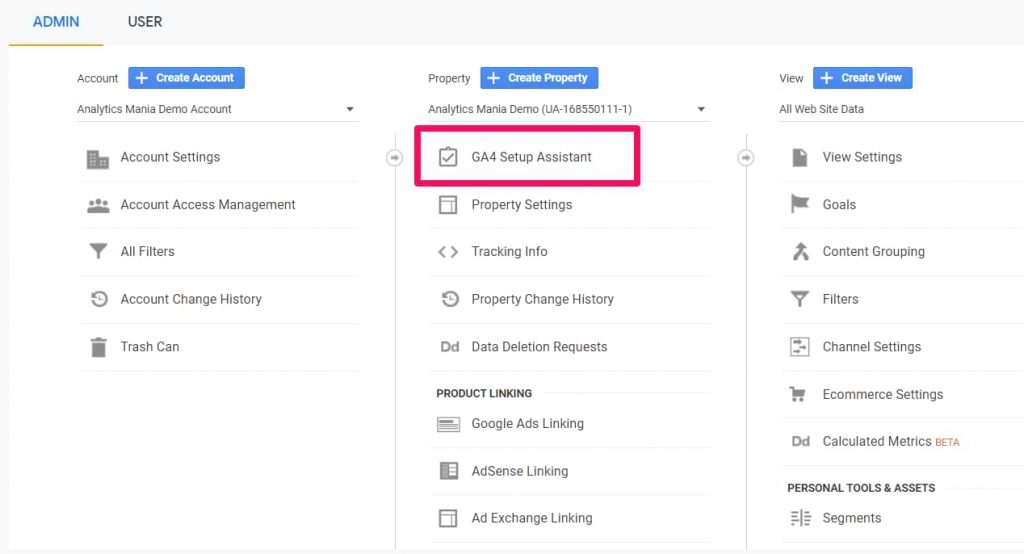
Once you are familiar with these new capabilities, let us set up your latest Google Analytics 4 account.
- Navigate to Admin to upgrade existing Google Analytics properties. Click on the button “Upgrade to Google Analytics 4 Property” under Property. Click “Get Started” under “I Need to Create a New Google Analytics 4 Property.”
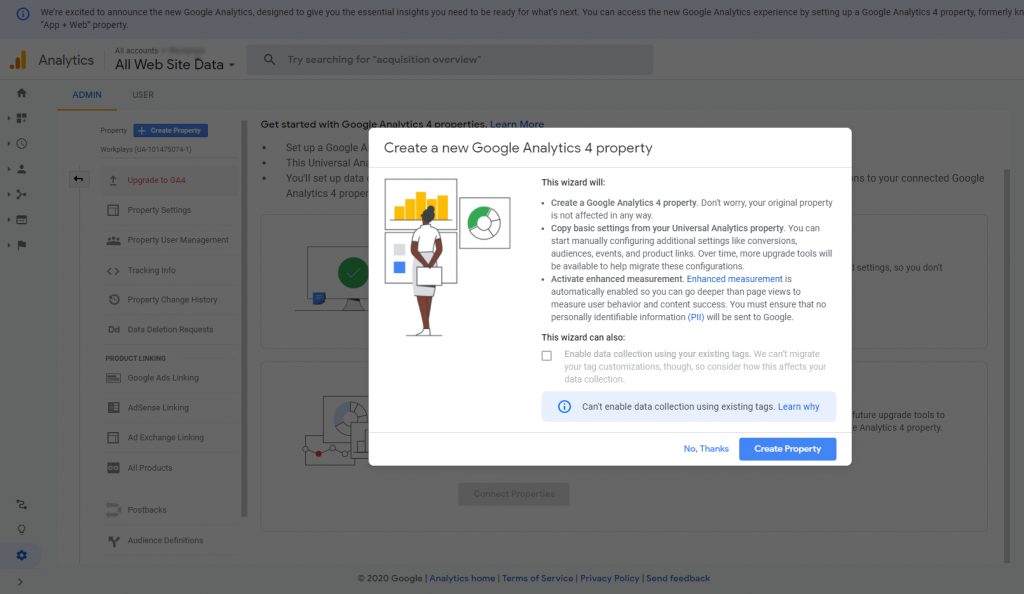
The gtag.js tag can be used to enable data collection if it is already installed on your website. Your website doesn't need to be updated with a tracking code. Before you decide to use this option, experts recommend that you should read the Google Analytics help documentation about the connected site tags.
- If you're using Google Tag Manager to implement my tags, be sure to use the UA ID of my property instead of gtag.js.
When you click on the Continue button, you'll be redirected to the recent Google Analytics 4 account's property settings.
- If your website already has a tracking tag, follow these steps:
Go to the old Google Analytics property, then choose “Tracking Info”, and click on “Tracking Code”. You're good to go if you notice the new Google Analytics 4 measurement ID in “Connected Site Tags”.
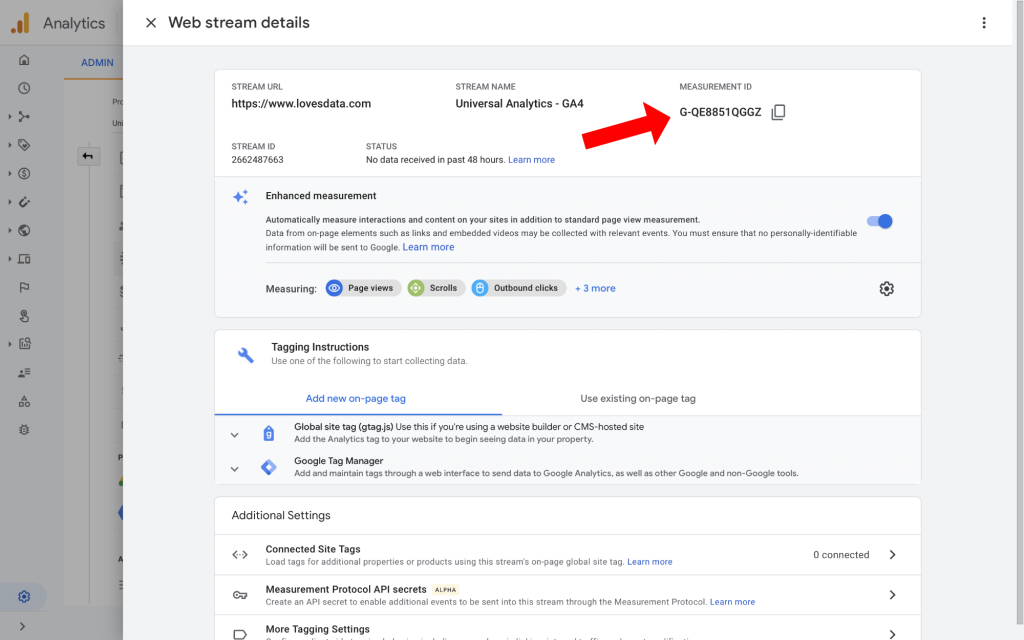
- If you want to use the new tracking tag, you may follow these instructions:
Go to Admin, click “Setup Assistant”, and click “Tag Installation” under the new Google Analytics 4 property you created. You will be directed to the menu “Data Streams”.
This is where you inform Google about the source of your data. Your website link should be there; click on your website link to see your new gtag.js tracking code and measurement ID, which you should now install on your website.
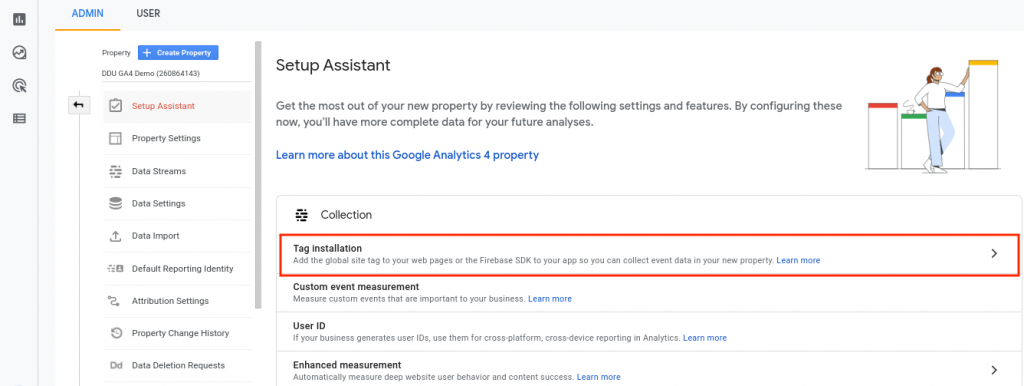
- If you are using Google Tag Manager, you can make the following changes:
Go to Google Tag Manager, create a new tag, and then select “Google Analytics: GA4 Configuration”. First, copy and then paste your measurement ID, which is located under “Data Streams”. After that, set the trigger to “All pages”, publish your tag, and save them.
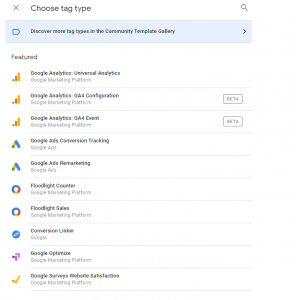
It is a very simple setup. This will allow your Google Analytics 4 property to traffic across your website. You can also select Admin and click on the “Setup Assistant” link to your Google Ads account. Here you can set user IDs, define audiences, and much more.
Conclusion
Universal Analytics vs. Google Analytics Version 4: Clearly, Google Analytics 4 (GA4) and Universal Analytics have significant differences. And it's essential that you thoroughly understand these steps before attempting to switch over.

Shivanjali, a Digital Marketing Expert, regularly contributes to various industry-specific magazines. She is interested in tech statistics, SMO, and raising awareness about technical how-to guides. She can often be found exploring different places on weekends.